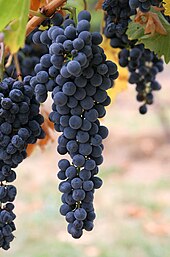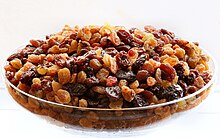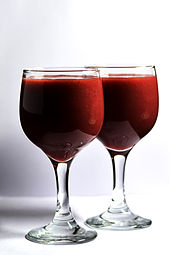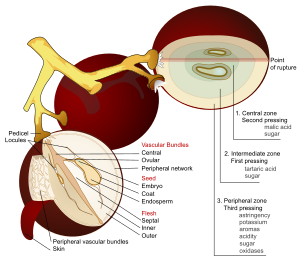Grape


A grape is a fruit, botanically a berry, of the deciduous woody vines of the flowering plant genus Vitis. Grapes are a non-climacteric type of fruit, generally occurring in clusters.
The cultivation of grapes began perhaps 8,000 years ago, and the fruit has been used as human food over history. Eaten fresh or in dried form (as raisins, currants and sultanas), grapes also hold cultural significance in many parts of the world, particularly for their role in winemaking. Other grape-derived products include various types of jam, juice, vinegar and oil.
| Nutritional value per 100 g (3.5 oz) | |
|---|---|
| Energy | 288 kJ (69 kcal) |
18.1 g | |
| Sugars | 15.48 g |
| Dietary fiber | 0.9 g |
0.16 g | |
0.72 g | |
Niacin (B3) | 1% 0.188 mg |
| Pantothenic acid (B5) | 1% 0.05 mg |
| Vitamin B6 | 5% 0.086 mg |
| Folate (B9) | 1% 2 μg |
| Choline | 1% 5.6 mg |
| Vitamin C | 4% 3.2 mg |
| Vitamin E | 1% 0.19 mg |
| Vitamin K | 12% 14.6 μg |
| Minerals | Quantity %DV† |
| Calcium | 1% 10 mg |
| Iron | 2% 0.36 mg |
| Magnesium | 2% 7 mg |
| Manganese | 3% 0.071 mg |
| Phosphorus | 2% 20 mg |
| Potassium | 6% 191 mg |
| Sodium | 0% 2 mg |
| Zinc | 1% 0.07 mg |
| Other constituents | Quantity |
| Water | 81 g |
| †Percentages estimated using US recommendations for adults,[1] except for potassium, which is estimated based on expert recommendation from the National Academies.[2] | |
History
The
The
In 2005 a team of archaeologists concluded that some Chalcolithic wine jars, which were discovered in Cyprus in the 1930s, were the oldest of their kind in the world, dating back to 3,500 BC.[11] Moreover, Commandaria, a sweet dessert wine from Cyprus, is the oldest manufactured wine in the world, its origins traced as far back as 2000 BC.[12]
In North America, native grapes belonging to various species of the genus Vitis proliferate in the wild across the continent, and were a part of the diet of many
Description
Grapes are a type of
Nutrition
Raw grapes are 81% water, 18%
Grapevines

Most domesticated grapes come from cultivars of Vitis vinifera, a grapevine native to the Mediterranean and Central Asia. Minor amounts of fruit and wine come from American and Asian species such as:
- Vitis amurensis, the most important Asian species
- Concord cultivar), sometimes used for wine, are native to the Eastern United States and Canada.
- Vitis mustangensis (the mustang grape), found in Mississippi, Alabama, Louisiana, Texas, and Oklahoma
- Vitis riparia, a wild vine of North America, is sometimes used for winemaking and for jam. It is native to the entire Eastern United States and north to Quebec.
- Vitis rotundifolia (the muscadine), used for jams and wine, is native to the Southeastern United States from Delaware to the Gulf of Mexico.
Trade
| Rank | Country | 2017 | 2018 | 2019 | 2020 | 2021 |
|---|---|---|---|---|---|---|
| 1 | Peru | 673.4M | 847.3M | 917.9M | 1.0B | 1.5B |
| 2 | Chile | 1.2B | 1.2B | 1.2B | 1.0B | 927.1M |
| 3 | Netherlands | 653.3M | 778.1M | 721.8M | 794.5M | 916.5M |
| 4 | South Africa | 572.0M | 567.4M | 553.4M | 567.2M | 907.3M |
| 5 | Italy | 864.8M | 800.1M | 724.8M | 835.1M | 876.7M |
| 6 | United States | 904.9M | 926.6M | 857.2M | 825.2M | 782.7M |
| 7 | China | 735.4M | 690.1M | 987.4M | 1.2B | 757.3M |
| 8 | Spain | 338.4M | 410.9M | 343.6M | 471.6M | 516.8M |
| 9 | Australia | 286.4M | 286.9M | 386.5M | 432.2M | 344.5M |
| 10 | India | 281.7M | 279.2M | 320.1M | 295.9M | 336.4M |
| - | World | 8.5B | 8.7B | 9.0B | 9.5B | 9.9B |
| Source: Tridge | ||||||
Distribution and production

According to the Food and Agriculture Organization (FAO), 75,866 square kilometers of the world are dedicated to grapes. Approximately 71% of world grape production is used for wine, 27% as fresh fruit, and 2% as dried fruit. A portion of grape production goes to producing grape juice to be reconstituted for fruits canned "with no added sugar" and "100% natural". The area dedicated to vineyards is increasing by about 2% per year.
There are no reliable statistics that break down grape production by variety. It is believed that the most widely planted variety is Sultana, also known as Thompson Seedless, with at least 3,600 km2 (880,000 acres) dedicated to it. The second most common variety is Airén. Other popular varieties include Cabernet Sauvignon, Sauvignon blanc, Cabernet Franc, Merlot, Grenache, Tempranillo, Riesling, and Chardonnay.[18]
| Country | Area (km2) |
|---|---|
| 11,750 | |
| 8,640 | |
| 8,270 | |
| 8,120 | |
| 4,150 | |
| 2,860 | |
| 2,480 | |
| 2,160 | |
| 2,080 | |
| 1,840 | |
| 1,642 | |
| 1,459 |
| Rank | Country | 2009 | 2010 | 2011 | 2012 | 2020 |
|---|---|---|---|---|---|---|
| 1 | 8,038,703 | 8,651,831 | 9,174,280 | 9,600,000 F | 14,769,088 | |
| 2 | 6,629,198 | 6,777,731 | 6,756,449 | 6,661,820 | 8,222,360 | |
| 3 | 8,242,500 | 7,787,800 | 7,115,500 | 5,819,010 | 6,817,770 | |
| 4 | 6,101,525 | 5,794,433 | 6,588,904 | 5,338,512 | 5,884,230 | |
| 5 | 5,535,333 | 6,107,617 | 5,809,315 | 5,238,300 | 5,388,679 | |
| 6 | 4,264,720 | 4,255,000 | 4,296,351 | 4,275,659 | 4,208,908 | |
| 7 | 2,600,000 | 2,903,000 | 3,149,380 | 3,200,000 F | 3,125,000 | |
| 8 | 2,181,567 | 2,616,613 | 2,750,000 | 2,800,000 F | 2,772,561 | |
| 9 | 2,305,000 | 2,225,000 | 2,240,000 | 2,150,000 F | 2,055,746 | |
| 10 | 1,748,590 | 1,743,496 | 1,683,927 | 1,839,030 | 2,028,185 | |
| — | World | 58,521,410 | 58,292,101 | 58,500,118 | 67,067,128 | 78,034,332 |
Table and wine grapes

Commercially cultivated grapes can usually be classified as either table or wine grapes, based on their intended method of consumption: eaten raw (table grapes) or used to make wine (wine grapes). The sweetness of grapes depends on when they are harvested, as they do not continue to ripen once picked.[21] While almost all of them belong to the same species, Vitis vinifera, table and wine grapes have significant differences, brought about through selective breeding. Table grape cultivars tend to have large, seedless fruit (see below) with relatively thin skin. Wine grapes are smaller, usually seeded, and have relatively thick skins (a desirable characteristic in winemaking, since much of the aroma in wine comes from the skin). Wine grapes also tend to be very sweet: they are harvested at the time when their juice is approximately 24% sugar by weight. By comparison, commercially produced "100% grape juice", made from table grapes, is usually around 15% sugar by weight.[22]
Seedless grapes
Seedless cultivars now make up the overwhelming majority of table grape plantings. Because grapevines are vegetatively propagated by cuttings, the lack of seeds does not present a problem for reproduction. It is an issue for breeders, who must either use a seeded variety as the female parent or rescue embryos early in development using tissue culture techniques.
There are several sources of the seedlessness trait, and essentially all commercial cultivators get it from one of three sources:
An offset to the improved eating quality of seedlessness is the loss of potential health benefits provided by the enriched phytochemical content of grape seeds (see Health claims, below).[24][25]
Uses
Culinary
Grapes are eaten raw, dried (as raisins, currants and sultanas), or cooked. Also, depending on grape cultivar, grapes are used in winemaking. Grapes can be processed into a multitude of products such as jams, juices, vinegars and oils. Commercially cultivated grapes are classified as either table or wine grapes. These categories are based on their intended method of consumption: grapes that are eaten raw (table grapes), or grapes that are used to make wine (wine grapes). Table grape cultivars normally have large, seedless fruit and thin skins. Wine grapes are smaller (in comparison to table grapes), usually contains seeds, and have thicker skins (a desirable characteristic in making wine. Most of the aroma in wine is from the skin. Wine grapes tend to have a high sugar content. They are harvested at peak sugar levels (approximately 24% sugar by weight.) In comparison, commercially produced "100% grape juice" made from table grapes are normally around 15% sugar by weight.[26]
Raisins, currants and sultanas

In most of Europe and North America, dried grapes are referred to as "raisins" or the local equivalent. In the UK, three different varieties are recognized, forcing the EU to use the term "dried vine fruit" in official documents.
A raisin is any dried grape. While raisin is a French loanword, the word in French refers to the fresh fruit; grappe (from which the English grape is derived) refers to the bunch (as in une grappe de raisins). A raisin in French is called raisin sec ("dry grape").
A currant is a dried Zante Black Corinth grape, the name being a corruption of the French raisin de Corinthe (Corinth grape). The names of the black and red currant, now more usually blackcurrant and redcurrant, two berries unrelated to grapes, are derived from this use. Some other fruits of similar appearance are also so named, for example, Australian currant, native currant, Indian currant.[27]
A sultana was originally a raisin made from Sultana grapes of Turkish origin (known as Thompson Seedless in the United States), but the word is now applied to raisins made from either white grapes or red grapes that are bleached to resemble the traditional sultana.
Juice

Grape juice is obtained from crushing and blending grapes into a liquid. The juice is often sold in stores or
Pomace and phytochemicals
Winemaking from red and white grape flesh and skins produces substantial quantities of organic residues, collectively called pomace (also "marc"), which includes crushed skins, seeds, stems, and leaves generally used as compost.[29] Grape pomace – some 10-30% of the total mass of grapes crushed – contains various phytochemicals, such as unfermented sugars, alcohol, polyphenols, tannins, anthocyanins, and numerous other compounds, some of which are harvested and extracted for commercial applications (a process sometimes called "valorization" of the pomace).[29][30]
Skin

The flavonols syringetin, syringetin 3-O-galactoside, laricitrin and laricitrin 3-O-galactoside are also found in purple grape but absent in white grape.[35]
Seeds
Muscadine grape seeds contain about twice the total polyphenol content of skins.
Resveratrol
Resveratrol, a
Health claims
French paradox
Comparing diets among Western countries, researchers have discovered that although French people tend to eat higher levels of animal fat, the incidence of

Although adoption of wine consumption is generally not recommended by health authorities,[42] some research indicates moderate consumption, such as one glass of red wine a day for women and two for men, may confer health benefits.[43][44][45] Alcohol itself may have protective effects on the cardiovascular system.[46]
Grape and raisin toxicity in dogs
The consumption of grapes and raisins presents a potential health threat to dogs. Their toxicity to dogs can cause the animal to develop
In religion
Christians have traditionally used wine during worship services as a means of remembering the
The Catholic Church continues to use wine in the celebration of the Eucharist because it is part of the tradition passed down through the ages starting with Jesus Christ at the Last Supper, where Catholics believe the consecrated bread and wine become the body and blood of Jesus Christ, a dogma known as transubstantiation.[49] Wine is used (not grape juice) both due to its strong Scriptural roots, and also to follow the tradition set by the early Christian Church.[50] The Code of Canon Law of the Catholic Church (1983), Canon 924 says that the wine used must be natural, made from grapes of the vine, and not corrupt.[51]
Gallery
-
Flower buds
-
Flowers
-
Immature fruit
-
Grapes in Iran
-
Wine grapes
-
Vineyard in the Troodos Mountains
-
seedless grapes
-
Grapes in the La Union, Philippines
See also
- Annual growth cycle of grapevines
- Drakshasava, a traditional Ayurvedic tonic made from grapes
- Grape syrup
- List of grape dishes
- List of grape varieties
- Menispermum canadense, a poisonous species resembling wild grapes
- Propagation of grapevines
- The Fox and the Grapes
References
- ^ United States Food and Drug Administration (2024). "Daily Value on the Nutrition and Supplement Facts Labels". Retrieved 2024-03-28.
- )
- ^ "ANGŪR – Encyclopaedia Iranica". iranicaonline.org. Retrieved 2021-04-06.
According to A. de Candolle (L'Origine des plantes cultivées, Paris, 5th ed., 1912, p. 152) the grape-vine is at home in the region south of the Caucasus, from the Black Sea to the Caspian region of Iran, where "it has the shape of a strong liana climbing over high trees and producing abundant fruit without any pruning or cultivation." His statement is still generally accepted, since the greatest diversity in varieties can be observed there.
- PMID 16872714. Archived from the original(PDF) on 2013-10-04.
- ^ McGovern, Patrick E. (2003). Ancient Wine: The Search for the Origins of Viniculture (PDF). Princeton University Press. Archived (PDF) from the original on 2013-10-04.
- ^ McGovern, P. E. "Georgia: Homeland of Winemaking and Viticulture". Archived from the original on 2013-05-30.
- ^ Keys, David (2003-12-28) Now that's what you call a real vintage: professor unearths 8,000-year-old wine Archived 2013-06-03 at the Wayback Machine. archaeology.ws.
- ^ Owen, James (12 January 2011). "Earliest Known Winery Found in Armenian Cave". National Geographic. Archived from the original on 2017-06-03. Retrieved 8 July 2017.
- ISBN 1-84000-972-1.
- ^ "Grape". Better Health Channel Victoria. October 2015. Archived from the original on 2018-01-09. Retrieved 8 July 2017.
- ^ "Wine History Cyprus".
- ^ "Oldest manufactured wine". Guinness World Records.
- ISBN 1-85732-999-6), pp. 8, 18, 228.
- PMID 17316172.
- S2CID 36937910.
- PMID 14599515.
- ^ Top 20 grape producing countries in 2012 Archived 2011-07-13 at the Wayback Machine faostat.fao.org.
- ^ "The most widely planted grape in the world". freshplaza.com. Archived from the original on 2013-05-10. Retrieved 2010-04-10.
- UN Food & Agriculture Organization. 2011. Archived from the originalon 2011-07-13. Retrieved 2014-02-12.
- ^ "Ranking Of Countries That Produce The Most Grapes". beef2live.com. Retrieved 2022-02-15.
- ^ Grapes, Sour or Sweet, Are Ripe for Dessert
- ^ "WineLoversPage – Straight talk in plain English about fine wine". WineLoversPage. Archived from the original on 2011-07-16.
- ^ Reisch BI, Peterson DV, Martens M-H. "Seedless Grapes" Archived 2008-06-19 at the Wayback Machine, in "Table Grape Varieties for Cool Climates", Information Bulletin 234, Cornell University, New York State Agricultural Experiment Station, retrieved December 30, 2008.
- PMID 14977436.
- PMID 16719495.
- ^ "WineLoversPage – Straight talk in plain English about fine wine". WineLoversPage. Archived from the original on 2011-07-16.
- ^ "currant". Oxford English Dictionary (Online ed.). Oxford University Press. (Subscription or participating institution membership required.)
- ^ "Thompson Seedless Grape Juice". sweetwatercellars.com. Archived from the original on 2012-03-25. Retrieved 2012-02-17.
- ^ S2CID 93000616.
- PMID 29132780.
- ^ PMID 12236700.
- S2CID 98822789. Archived from the originalon 2006-11-19. Retrieved 2006-11-21.
- ^ PMID 27542461.
- PMID 12926904.
- PMID 17002441.
- PMID 15740076.
- PMID 16910717.
- S2CID 29294873.
- ^ "Resveratrol". Micronutrient Information Center, Linus Pauling Institute, Oregon State University, Corvallis, OR. 11 June 2015. Retrieved 26 August 2019.
- PMID 17090126.
- PMID 17274460.
- ^ Alcohol, wine and cardiovascular disease. American Heart Association.
- ^ Alcohol. Harvard School of Public Health.
- PMID 17971339.
- S2CID 260368051.
- S2CID 95931627.
- ^ Raisins/Grapes Archived 2007-09-29 at the Wayback Machine. The Merck Veterinary Manual.
- ^ "Why do most Methodist churches serve grape juice instead of wine for Holy Communion?". The United Methodist Church. Retrieved 2007-07-07.
- ^ "Catechism of the Catholic Church, 1413". Vatican.va. Archived from the original on 2011-06-09. Retrieved 2012-02-01.
- ^ "The Real Presence of Christ in the Eucharist". Newadvent.org. 1909-05-01. Archived from the original on 2012-01-11. Retrieved 2012-02-01.
- ^ "Altar wine, Catholic encyclopedia". Newadvent.org. 1907-03-01. Archived from the original on 2012-02-05. Retrieved 2012-02-01.
Further reading
- Creasy, G. L. and L. L. Creasy (2009). Grapes (Crop Production Science in Horticulture). CABI. ISBN 978-1-84593-401-9.








